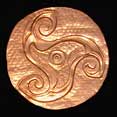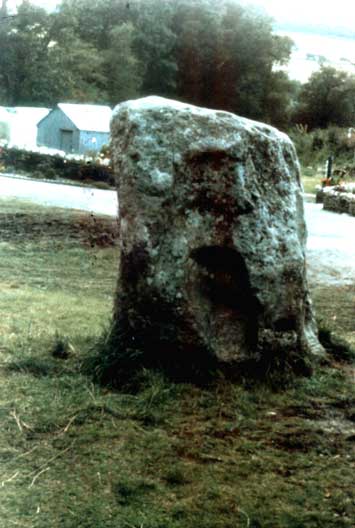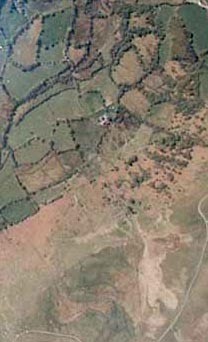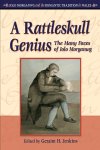A Tribute to the work of Lewis Edwards
text translation service for many worldwide languages
“The Pumpsaint Temple of the Stars”
Lewis Edwards, D.Litt., 26th. July, 1947
“The discovery of “The Temple of the Stars”, a zodiacal circle fashioned by hills, roads and rivers in the Glastonbury area greatly strengthened its connection with the Arthurian tradition and proved a partial commentary on “The High History of the Holy Grail”, which in the Everyman Edition edited by Dr. Sebastian Evans, contained a map showing the circle of the Zodiac. A full description of the Temple with aeroplane photographs has been given in Mrs, Maltwood’s publication, “A Guide to Glastonbury’s Temple of the Stars” and “Air View Supplement to Glastonbury’s Temple of the Stars”.
effigies to a one inch map of the Glastonbury area some place names were noticed which were similar to names of places in Wales. Dr. Ardour Stephens in his article to the S. Wales Press held the theory that the true site of the Arthurian legend was in S. Wales, particularly in the region of Pembrokeshire, Carmarthenshire and W. Glamorganshire. Thus we were led to the conclusion that if air photographs of this area could be taken. a similar Temple might be found in Wales. The probability that such a Temple would be closely related to the Druidical religion led to the possibility of one being in Angelsey, which was pre-eminently a centre of the Druids. However, a careful study of maps revealed that at the junction of Nant Gwynan and the Cothi there was the outline of an effigy of Leo (the Lion) resembling that of Glastonbury.
As the name of the signs of the Zodiac may not be familiar to all, this old verse may be helpful:
The Ram, the Bull, the Heavenly Twins, And next the Crab, the Lion shines. The Virgin and the Scales The Scorpion, Archer, and the Goat, The Man that bears the Watering Pot And the Fish with the glittering scales.
The discovery of the sign of Leo was soon followed by the recognition of Argo (the Ship) and of an effigy representing what might be Cancer, each in its appropriate position. It was an exciting moment and it was clear that here was a Temple of the Zodiac almost identical with that of Glastonbury. In Wales its significance was greater. ‘Sidydd’ is the Welsh word for Zodiac, Caer Sidi the ‘Paradise’ of ancient Welsh literature, has always puzzled commentators. May it not be a reference to the Circle of the Zodiac formed by the hills, rivers and valleys of the Pumpsaint area of Carmarthenshire? One hesitates to conjure up possible references to the old mythology and these must be left for further research and elucidation.
Below Llan-y-crwys there is an area bounded by Sarn Helen, the road leading from Pumpsaint to Ffald-y-Brenin and that from Ffald-y-Brenin to Farmers. Approximately the centre of this area is the centre point of the Zodiacal Circle. With a radius representing 5.6 miles a circle can be drawn covering an area of 100 sq.miles which is the area of the circle. AQUARIUS:
At the northern part of the circle stands the hill known as Bryn Cysegrfan. What a revealing name, the ‘Hill of the Sacred Place’. It is immediately south of the area described in Rees’ “Lives of the Saints” as ‘The Sanctuary of St. David‘. By following the contours of the hill and the road crossing and surrounding it, an effigy resembling a cat can be delineated some would find a greater resemblance to a squirrel. In Mrs. Maltwood’s illustration of the Glastonbury Temple this position is occupied by a similar figure which includes the sacred area of Avalon, the seat of The Round Table of King Arthur and his Knights. This effigy, that of Aquarius the Waterman, is directly opposite that of Leo in the south. A line joining the carn on the hill to the junction of Nant Gwynan with the Cothi passes through the centre of the circle. The effigy descends from the hill to Glan yr Afon Cottages, thus forming a foot. Then its boundary passes westward along Nant Clywedog Uchaf, enclosing Llanfair Clydogau where it crosses the Teify turning northwards along the footpath to the farm Parc Neuadd and along the footpath to the woods Allt Clwtypatrwn where it turns east to the Teify, thus forming the outline of a bushy tail. PISCES: (the Fishes)
Moving anti-clockwise this is the next sign of the Zodiac. In its appropriate position near Lampeter are the woods – Long Wood, Coed Gwarallt and Olwen Wood. Pisces is always depicted by two fishes: here arises the problem, which of these are the remains of woods established thousands of years ago? It is a complex problem for each wood is guarded on the South-East by an Earth-work, Castell Goetre at Long Wood, Castell Allt Goch at Coed Gwaralit. In these two instances the entrenchments are close up to the sides of the woods. Olwen Woods, the southernmost plantation has Castell Olwen on its west side and.Castell Bugad half a mile to the south east. The distance of Castell Bugad from Olwen Woods and the position of the woods relative to that of the other signs of the Zodiac lend support to the impression that the two northerly woods represent Pisces. ARIES: (the Ram)
is the next sign. Ram is the name of the district south of the sign of Pisces. The effigy is formed by the westerly Sarn Helen. There is another Sarn Helen, already referred to, leading north from Pumpsaint and passing out of the circle at Llanfair Clydogau. At Cwmann there is a road going eastwards past Tre Herbert to Ram Inn where it turns south. Here are two roads which may be followed the inner one running directly to the farm Ty Hywel, whilst the other has to be left at Rhiwlas and a line across country followed to Ty Hywel. The inner road gives the distinct form of the fore part of a Ram, its head clearly defined, but it is looking forward. The conventional form of the Ram has its head turning backwards, which is the form shown by following the outer road. The choice is important; we do not know when the conventional figure was introduced, the forward position of the head may be an earlier characteristic. An old Indian Zodiac, depicted as a square in Oedious Judaicus” published privately by the author Sir W. Drummond, has the Ram looking forward but no date has been ascribed by him to this Glastonbury Zodiac, the head is turned westwards towards the setting sun. The importance of the distinction in helping to fix the date of the Welsh Zodiac is obvious. The southern boundary runs from Ty Hwel past the cairn on Pencarreg and follows a track until it reaches the road junction at Blaen-bydernin, then runs north-west to Pant-y-fen on the circumference. The completion of the figure continues beyond the boundary of the Circle. From Cwmann a road running directly southeast crosses the head of the Ram. Halfway across to the west of the road there is a small lake which forms the eye of the Ram. TAURUS: (the Bull)
comes next. Its position is nearer the centre of the Circle, just below Cross Hands, whilst the other signs are on or near the circumference. The place, possibly indicating this sign, must have undergone a change, or it may be only accidental, that Cil-yr-Ychain (the shelter of the oxen) occupies a position within the outlines of this effigy. This is a clearly defined hill which can be followed by the 1000 ft. contour on the one-inch map (National Grid Issue No.140). Returning to the six inch map, one leaves the contour at the farm Ty’n-y-grug and follows the stream Nant Thames until it is touched by the track leading past Capel Esgair Dawe. The track is followed as it bonds to the northwest and forms the snout of the Bull. The road leading past Llwyn Owen and Hendre Las to the road junction where a road leads back to Cross Hands forms the western and northern boundary.
Between Penrhiw and Blaen-y-nant, near the north-east corner of the figure, two dips are marked on the map, the one nearest Blaen-y-nant forms the eye of the Bull. It will be noticed that the Bull has an ear and two horns, these and the eye are important pointers to other positions.
In the conventional Zodiac the next two signs are Gemini and Cancer, but this Zodiac and the Glastonbury one, introduce three signs of the Southern constellations, Orion, Argo Navis and Hydra. This is of great significance and indicates that the Culture which raised these two Zodiacs must have been brought to Britain by peoples who were familiar with the northern and southern constellations which leads to the tradition of the lost continent of Atlantis, believed to have been in the Atlantic between Europe, the northern part of Africa and Central America and the northern part of South America. Within such a continent the northern and southern constellations would be known. This hypothesis points to the Culture moving eastwards and consequently from Britain into Europe rather than westwards from Europe into Britain. ORION:
The figure of Orion is on the circumference ,almost due west of Taurus, which is its position within the Constellations. It is represented by the figure of a Man with his head bent downwards and one arm raised and bent above his head. The outline of the arm is formed on the lower side by Nant Rhyd-y-mwyn which it leaves at Clyn Byr and the upper part by a track running almost parallel to the stream. The forearm and back of the figure are outlined by a sharp bend in the track running due west until it merges into the hill, the inner side of the fore-arm by a parallel track which leads to Nant Ceiment which in its turn outlines the top of the head. At the fore below Maes Pwll the boundary follows Nant Wenallt to the track which leads from the stream past Bench Mark .069.7 until it reaches the farm Rhiwyrerfyn. ARGO:
Further to the south and a little towards the centre is the effigy Argo Navis (the Ship) represented by the wood Allt Tan-y-coed. HYDRA:
Between Argo and Leo the map reveals a figure in some degree similar to that at Glastonbury. It is marked as marshy land lying between the farms Pant Mawr and Pyllau’s Eurych, the latter an intriguing name. The figure is not clear but can be delineated by following the outlines of fields, wells or hedges. It is noticeable that in the Welsh Zodiac these two figures do not receive the same bold treatment that is given to them Glastonbury Zodiac. LEO: (the Lion)
is clearly defined and rightly placed to the south. It appears as a fierce animal representing the Sun in its midday glory. Its mouth is open, widely open and indicated by the woods Allt Cwm Cadno and Allt y Rhydiau. One fore paw formed by Coed Pistyll Gwyn is raised, the other formed by Coed Careg and Nant Gwynan stretches down towards the circumference of the Circle. The lower part of the body is formed by Nant Gwynan, a name not inappropriate to the Sun at its zenith. Its hind leg (one only appears) is formed by the junction of the Gwynan and the Cothi. From the head the neck falls sharply following the track from the farm Hafod-y-maidd towards Nant Gwynan. The tail is formed by the roads running west of the Cothi and has its end at a wood adjoining the road between the farms Bryn-fedwen and Penarth-ganol. VIRGO: (the Virgin) and LIBRA: (the Balance)
are believed by some to have become separate signs at a comparatively late date. One was said to have been a sacred sign and consequently not indicated, but the position of the two signs was indicated by one sign, Virgo with her sheaf of corn. The introduction of three signs of the Southern Constellations instead of Gemini and Cancer would give thirteen signs of the Zodiac. The merging of Virgo and Libra into one sign gives the required twelve.
It is situated here directly opposite to the entrance of the Temple and indicates an aspect in the development of the soul the meaning of which is not known to us. The figure of the Serpent is not found in the Glastonbury Temple. Does this mean that the desecration of the symbol of the Serpent had occurred in the period between the building of the Pumpsaint and the founding of the Glastonbury Temple? SCORPIO:
To the north-east of Virgo the boundary of Coed Maes-yr-haidd gives the outline of Scorpio’s torch. Moving directly east to Rhiw Garegog the stem of the torch moulds into the body of the effigy which is formed on the north-west side by a track leading to the source of Nant Dar. The southern boundary leads from Rhyd Ddu and follows a tributary of Avon Gwenlas. The head of the figure is formed by Nant Dar until it joins the Cothi at Pant-glas. Here its boundary follows the Cothi to its source, where the valley of Nant-y-Gerdinen and the fields east of the road leading to the farm Garthyhhy and beyond to the spring, form the figure of its claw. The bend of the Cothi at the waterfall gives a very vivid figure of a claw. SAGITTARIUS: (the Archer)
This figure is unmistakable. The half-inch map of S. Wales clearly shows the outline of a man on a horse. By following the 1,000 ft. contour on the one inch and the six inch maps, the figure can be deciphered with the ear of the horse, or it may be the hand of the rider, pointing towards the centre of the Circle. The main part of the effigy is made by the hills situated between the Cothi and the river Twrch. The bushy tail of the horse is formed by the eastern portion of Cefn Branddu, the western outline being formed by the track from the farm Gwndwn Mawr to the point where it reaches the stream flowing past Branddu.
The southern boundary is formed by the ridge Craig Branddu. This gives a reasonably conventional figure of Sagittarius but between the body of the rider and the horse’s ear there is a double track joined at both ends. The two tracks seem unnecessary but the whole outline with its southern boundary Afon Fanafas gives the distinct figure of a lance, a very unusual feature in a Zodiac. It functions as a pointer to other figures of the Circle which will be dealt with below.
CAPRICORNUS: (the Goat)
It has been pointed out that the centre of the Circle is within a well defined area and that the ear of Sagittarius is a pointer to the Centre, as is also the ear of Taurus. The northern side of Argo, if extended, leads to the central area whilst the extension of the southern side of Argo and a line drawn from the eye and along the straight part of the road passing through the northern horn of Taurus, join on a hill within a similar well defined area a mile north-west of Pumpsaint and to the west of Sarn Helen, the lance of Sagittarius also points in this direction. This area is immediately below the central area. The hill lies between the farms Bryn Eglwys fach and Bryn Eglwys fawr. Until aeroplane photographs and excavations have revealed the secrets of these two areas, their significance can only be conjectured. The central area is probably the site of the Outer Sanctuary, the southern area that of the Inner Sanctuary of the Temple.
A line drawn directly east between the two areas leads to the wood Allt Aber Mangoed which on the six inch map clearly takes the form of an Eagle with outstretched wings. The torch of Scorpio acts as a pointer to the Eagle. Below is a place named Tre-beddau – the place of the Graves. A similar figure is to be found in exactly the same position in the Glastonbury Zodiac. What of its significance ? The Eagle and the place of the Graves, does it not signify Death and Immortality ?
This is not the only burial place connected with the Temple. Outside the Circle, west of Lampeter, are three woods together which take the form of an extinct bird, a kind of Ouzel. The central wood is called Hen Feddau wood – the wood of the old Graves. Tre-beddau is apparently the burial place of the Initiates, Hen Feddau that of others connected with the worship of the Temple. North of the “Ouzel” are the woods Allt-y-dildre and Coed Cleid. Together they form the figure of a Leopard with its leg pointing towards the Circle. These two effigies guarded the entrance to the Circle which was from the west, the entrance itself being between the two signs of Pisces.
It has been shown that there are two sacred centres, the Inner and the Outer Sanctuaries, but Aquarius is situated on Bryn Cysygr Fan giving three sacred centres. Dr. Arbour Stephens has sought for the Welsh Avalon and identified it with the area of the three lakes of Ceredigion, equating Nant Afallon with Avalon. The culture of the Arthurian romance is indisputably built on the Zodiac. Here with the sign of Aquarius is the Welsh Avalon and here Arthur founded the sacred Order of the Round Table. “The High History of the Holy Grail” has been ascribed to the Glastonbury area, but it is essentially Welsh in character with its constant references to the Welsh leagues and Welsh customs. The conflict between the two sites is more apparent than real, but before we explain it, it should be noted that Arthur’s battles have never been ascribed to the Glastonbury area whilst Dr. Arbour Stephens very rightly placed them in south-west Wales, west and north of the Temple, which shows them to have been battles in defence of the Temple.
The date of the Pumpsaint Temple, at present, can only be conjectured, about 4,000 BC. Within the sign of Aquarius there is a standing stone, a little to the east of the centre line. Others in this area should be sought and, if found, may give the orientation of the Temple from which its date can be determined.”
Regretably most of the books of Katherine Maltwood have been out of print for many years, but another researcher, Mary Caine, who has made a life-long study of Katherine Maltwood’s “Temple of the Stars” in the Glastonbury area, which has just come back into print (July 2002). Caine’s books are also available, but only on special order from Amazon.co.uk
we first reproduced above was exactly as per the 1947 articles written by Lewis Edwards. There were many typos in the originals and we did our best to correct these, but we are indebted to June, of Bryn Cysegrfan, for sending us the correct spellings for a number of the placenames used in the now amended text above.
in, or are familiar with, the area between Lampeter and Llandovery, and recognise any further typos in the place-names, or know of the ‘original names’ of places whose names may have been ‘anglicised’ over the past few hundred years, please contact us and we will make the necessary amendments. Similarly, if you know of any Welsh, or English, astronomical terms that appear in place-names, or the names of farms or fields in the that area (or any other area of Wales) we would greatly appreciate hearing from you.
an independent researcher in the area, who is actively working on the Pumpsaint Zodiac Temple ideas of Lewis Edwards, and seeking the truth about the mysterious Caer Sidi, you are also most welcome to contact us if you would like to be a part of a future expedition team to the area. Our intended “Caer Sidi Expedition 2003”, which is currently in the planning stage, will focus on a re-evaluation of the pioneering work of Lewis Edwards, and hunt for more clues along the outlines of the geoglyphs, making a photographic survey and ‘findings record’ at each of the figures.
read Owen Morien Morgan’s classics
“The Mabin of the Mabinogion” “Light of Britannia”
the key to the ancient druidic astro-mythology
“A Rattleskull Genius: The Many Faces of Iolo Morganwg”
Geraint H. Jenkins (Editor)
EU English Edition
please take a look at our Ancient Mysteries Bookshoppe for a wide selection of books that challenge orthodox views of prehistory on every continent
|




